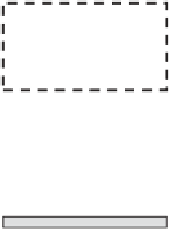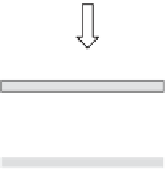Environmental Engineering Reference
In-Depth Information
Algal counts from filter membranes
Coverslip
This method involves passing a measured volume of
water sample through a membrane filter, and making
algal counts direct from the membrane. The proce-
dure does not require pre-concentration of the water
sample as the required population density needed for
counting can be obtained by adjusting the volume of
sample filtered. This technique has been used par-
ticularly in relation to marine phytoplankton, with
various modifications for staining and enumeration
(McNabb, 1960).
(a)
Cemented strip
(b)
Filtration
A suitable volume of sample (either
preserved or not) is filtered through a membrane fil-
ter paper having a pore size of 0.2 or 0.45 μm. The
recommended sample volume (Vollenweider, 1969)
is between 1 and 200 ml cm
−2
of filter membrane
surface although experience will tell the investigator
what volume is best for them. Cellulosic, polycar-
bonate or any other suitable filter material may be
used. To avoid uneven distribution of algae on the fil-
ter membrane surface, the sample should be carefully
added to the filter holder and allowed to stand for 2-3
min before applying the vacuum.
Gentle suction is now applied, avoiding the use of
excessive force since this can cause collapse of cells
onto the filter surface. Turn off the suction when there
is about 5 mm depth of liquid left above the filter and
allow the last sample to pass through very gently.
If an iodine-preserved sample has been used it may
be advantageous to wash away any excess iodine by
passing a small amount of distilled water through the
membrane, taking care not to disturb the distribution
of cells on the membrane during the washing pro-
cess. When filtration is complete, dry air should be
gently passed through the filter for a further minute
to remove excess moisture.
Chamber filled
with liquid
Figure 2.15
Lund nanoplankton counting chamber. (a)
Preparation of chamber. Cemented strips on glass slide
with separate coverslip. (b) Coverslip in place. Chamber
filled with water (for weighing and volume determina-
tion) or phytoplankton sample (cell/colony counts).
depth of liquid combined with a thinner coverslip,
allowing the use of high-power objectives and was
originally developed by Lund (1951).
The chamber can be constructed as follows. Take
a large no.1 cover slip. Using a diamond pencil cut
two strips about 3.0 mm wide. These are cemented to
a normal microscope slide about 1.6 cm apart and in
parallel with each other. Weigh the slide with its side
walls together with the complete cover slip that will
be used. A drop of DW is now introduced between
the cover slip ridges and the main complete cover slip
placedintop.Thewatershouldilltheentirechamber.
Any excess outside the chamber can be removed with
apieceofabsorbentilterpaper.Weighthewhole.The
difference between the dry weight and the wet weight
with a full chamber gives the volume of the cell. Dry
the cell and now introduce a well-mixed aliquot of
the sample to be collected. Count all cells by care-
fullytraversingthechamberbackwardsandforwards,
using the eye-piece cross hairs as a guide. It is advis-
able to pre-filter the sample through a phytoplankton
net mesh first to remove large colonial algae and long
filaments as these may clog the counting chamber.
Preparation for counting
Three different appr-
oaches may now be used, either singly or in combi-
nation.
1. For the first procedure it is essential to have used
membrane filters that are unaffected by ethanol.
The algal cells on the filter are dehydrated by






















Search WWH ::

Custom Search